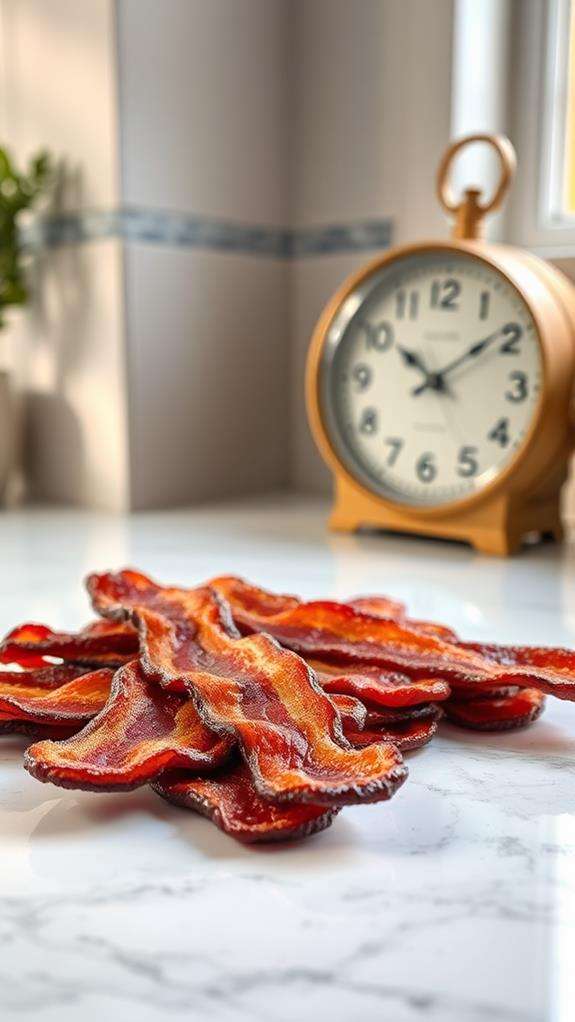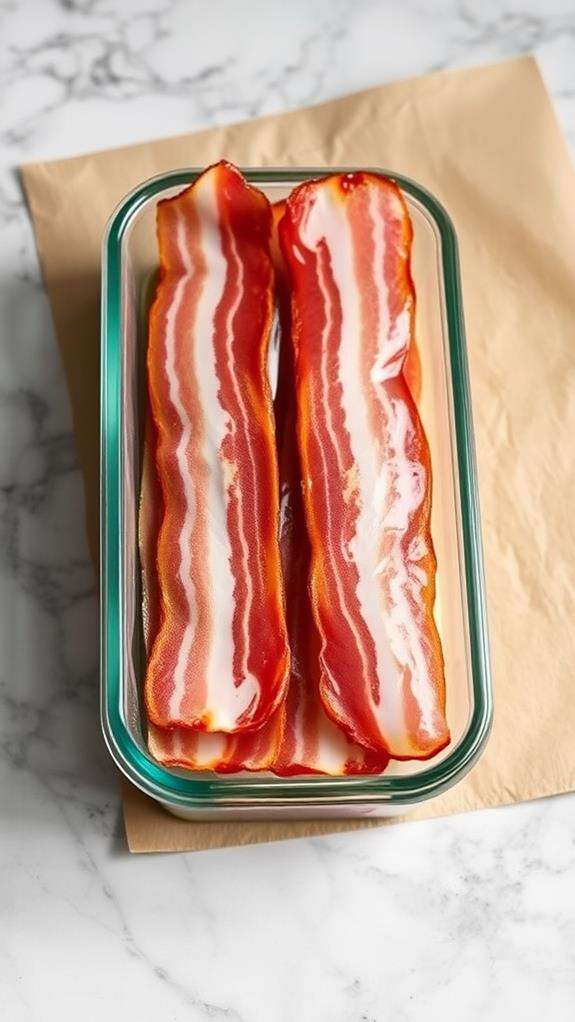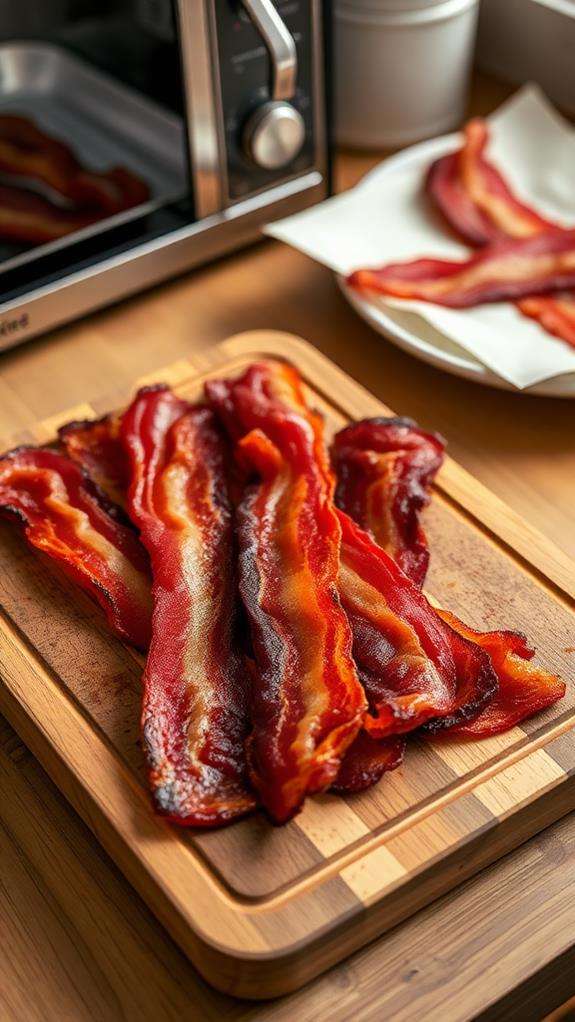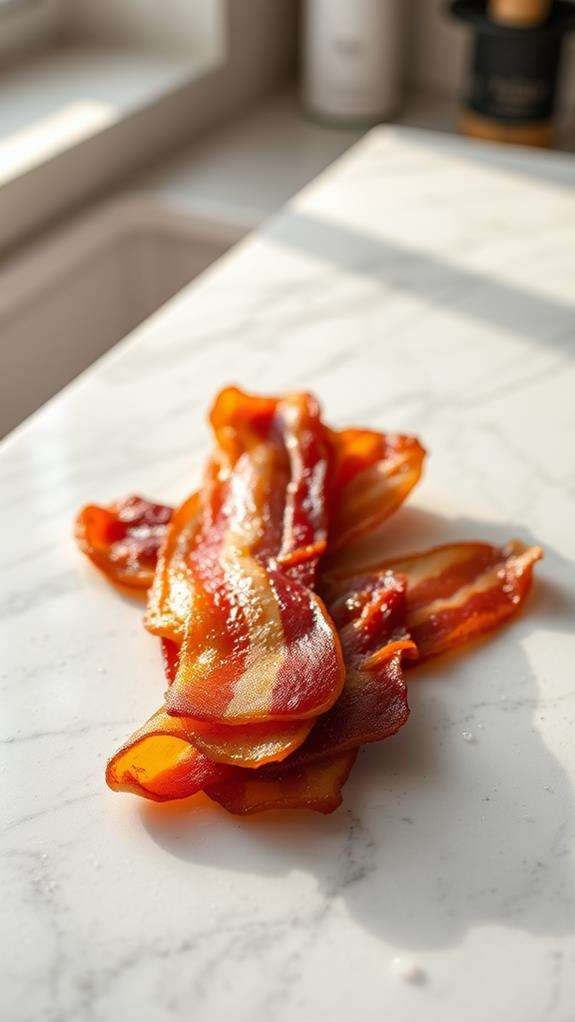How Long Does Cooked Bacon Last Out of the Fridge
Cooked bacon shouldn't stay at room temperature for more than 2 hours, and in warmer environments (above 90°F), you'll need to reduce that time to just 1 hour. Bacteria multiply rapidly in the "danger zone" between 40°F and 140°F, making your bacon unsafe to eat if left out too long. You'll know your bacon has spoiled if you spot discoloration, fuzzy mold spots, or a slimy texture, or if it develops a rancid smell. For ideal food safety, store your cooked bacon in airtight containers and refrigerate it within 2 hours of cooking. Understanding proper storage techniques can greatly extend your bacon's shelf life and maintain its quality.
This post may contain affiliate links. If you make a purchase through these links, I may earn a commission at no additional cost to you. Additionally, portions of this post may be generated using artificial intelligence (AI) technology. While we strive for accuracy, please be aware that AI-generated content may not always be perfect and should be fact-checked when necessary.
The Spatula Scoops
- Cooked bacon should not be left at room temperature for more than 2 hours due to potential bacterial growth.
- In warm environments above 90°F, cooked bacon must be refrigerated within 1 hour to remain safe.
- Bacteria multiply rapidly between 40°F and 140°F, making it unsafe to eat bacon left in this temperature range.
- Visible signs of spoilage include discoloration, slimy texture, or unusual odors when bacon sits out too long.
- If unsure about how long bacon has been at room temperature, it's safest to discard it.
Safe Room Temperature Storage Time

Cooked bacon shouldn't sit out at room temperature for more than 2 hours. The USDA's food safety guidelines indicate that this time limit applies to all cooked meats, as bacteria can multiply rapidly in what's known as the "danger zone" between 40°F and 140°F (4°C to 60°C). You'll want to be especially vigilant during warmer weather, as higher ambient temperatures can reduce this safe window to just 1 hour.
If you've left your bacon out longer than the recommended time, you'll need to discard it, even if it looks and smells fine. Bacteria like Staphylococcus aureus, E. coli, and Salmonella can grow to dangerous levels without visible signs of spoilage. When you're serving bacon at a gathering or buffet, you can use warming trays to maintain temperatures above 140°F, which will extend the safe serving time. For ideal food safety, you should either keep the bacon hot (above 140°F) or cold (below 40°F). If you're unsure how long the bacon has been sitting out, it's better to err on the side of caution and throw it away.
Signs of Spoiled Bacon

When checking if your cooked bacon has spoiled, you'll want to look for three key warning signs that tell you it's time to toss it out. The most obvious visual indicators include discoloration (especially green or gray patches), white or blue fuzzy spots of mold, and any slimy film on the surface. Your nose and fingers can also help detect spoilage, as rancid bacon will have a sour or rotten smell and may feel sticky or unusually slimy when touched.
Visual Warning Signs
Visual inspection provides the first line of defense against spoiled bacon. When you're examining cooked bacon that's been stored, you'll want to look for several distinct warning signs that indicate spoilage. If you notice any discoloration, particularly green, gray, or brown spots that weren't there before, it's time to discard the bacon.
Watch for changes in the bacon's surface texture, as a slimy or tacky coating is a clear indication of bacterial growth. You'll also want to check for any signs of mold, which typically appears as fuzzy spots in various colors, including white, green, or blue-gray patches. Even if the mold only affects one small area, you'll need to throw out the entire portion of bacon, as the microscopic spores have likely spread throughout.
Another visual indicator you shouldn't ignore is any unusual sheen or iridescent appearance on the meat's surface. While a slight rainbow effect can be normal in cured meats, an excessive or unusual metallic sheen, especially when combined with other warning signs, suggests that your bacon isn't safe to eat anymore.
Smell and Texture
A bacon's smell and texture provide essential clues about its freshness. When you're examining cooked bacon that's been stored, you'll want to rely on your senses to determine if it's still safe to eat. Fresh cooked bacon should maintain a pleasant, smoky aroma that's characteristic of cured pork. If you notice any sour, rancid, or unpleasant odors, it's time to discard the bacon.
- Slimy texture: If your cooked bacon develops a slick or slimy film on its surface, it's a clear indication of bacterial growth and spoilage
- Tacky feel: When bacon loses its firm, crispy texture and becomes sticky to touch, it's likely begun deteriorating
- Different smell: Any off-putting odors, including fishy, sour, or ammonia-like scents, indicate the bacon has gone bad
The texture of properly stored cooked bacon should remain relatively crisp and dry. When you touch it, it shouldn't feel wet or greasy beyond its natural state. If you're noticing changes in both smell and texture, don't take chances – it's better to dispose of the bacon than risk foodborne illness.
Proper Storage Methods

To keep your cooked bacon fresh and safe, you'll want to store it in an airtight container or high-quality resealable bag, making sure to remove as much air as possible before sealing. While you might be tempted to leave cooked bacon at room temperature for convenience, it's vital to refrigerate it within two hours of cooking to prevent dangerous bacterial growth. For the longest possible storage life, consider using a vacuum sealer, which can help preserve your cooked bacon's quality by completely removing air and creating a protective barrier against moisture and freezer burn.
Airtight Container Storage Methods
Storing cooked bacon properly in an airtight container helps maximize its shelf life and maintain its crispy texture. You'll want to select a container that's specifically designed for food storage, with a secure seal that prevents air and moisture from entering. Glass or BPA-free plastic containers with snap-lock lids work best for this purpose.
- Use containers with rubber gaskets or silicone seals to create an airtight environment that prevents oxidation and bacterial growth
- Layer your cooked bacon between sheets of paper towels within the container to absorb excess grease and maintain crispiness
- Choose appropriately sized containers to minimize excess air space, as too much air can accelerate spoilage
Before placing your bacon in the container, verify it's completely cooled to room temperature to prevent condensation from forming inside. You'll also want to press out as much air as possible before sealing the container. If you're storing multiple layers of bacon, make sure each layer is separated by paper towels. For best freshness, label your container with the storage date using a permanent marker or food storage label, which will help you track how long it's been stored.
Room Temperature Safety Tips
While airtight containers offer excellent storage options, leaving cooked bacon at room temperature requires careful attention to food safety guidelines. You'll need to monitor both time and temperature exposure to prevent harmful bacterial growth that can lead to foodborne illness.
| Safety Factor | Warning Signs | Recommended Action |
|---|---|---|
| Time Limit | Beyond 2 hours | Discard immediately |
| Temperature | Above 70°F | Reduce exposure time to 1 hour |
| Appearance | Color changes | Don't risk consumption |
| Texture | Slimy surface | Dispose of properly |
| Odor | Rancid smell | Remove from area |
When you're serving cooked bacon at room temperature, you shouldn't leave it out for more than two hours under normal conditions. If you're in a warmer environment where temperatures exceed 70°F, you'll need to reduce that time to just one hour. It's essential to place any leftover bacon in the refrigerator before these time limits expire. You can use a food thermometer to monitor the ambient temperature, and you should always err on the side of caution. If you're unsure about how long the bacon has been sitting out, it's safer to discard it rather than risk potential food poisoning.
Vacuum-Sealing for Preservation
Vacuum-sealing stands out as one of the most effective methods for extending your cooked bacon's shelf life. When you properly vacuum-seal your bacon, you're removing air that could lead to oxidation and bacterial growth, greatly increasing its storage duration. The process creates an anaerobic environment that helps maintain both flavor and texture, while preventing freezer burn if you're planning for long-term storage.
- Your vacuum-sealed cooked bacon can last up to 2-3 weeks in the refrigerator, compared to just 4-5 days when stored in regular containers or bags
- Using a commercial-grade vacuum sealer with heavy-duty bags will provide better results than consumer-grade alternatives
- For best preservation, verify your bacon has cooled completely before sealing to prevent moisture condensation inside the package
To maximize your vacuum-sealing efforts, you'll want to portion your bacon before sealing, making it easier to thaw and use specific amounts as needed. If you're planning to freeze your vacuum-sealed bacon, label each package with the date and quantity, as properly sealed and frozen bacon can maintain its quality for up to 6 months.
Food Safety Guidelines

Proper food safety guidelines are vital when handling cooked bacon to prevent foodborne illness. According to the USDA, you shouldn't leave cooked bacon at room temperature for more than two hours, or one hour if the ambient temperature exceeds 90°F (32°C).
When handling cooked bacon, you'll need to follow basic food safety protocols, including washing your hands thoroughly before and after touching the meat. Always use clean utensils and cutting boards, and don't cross-contaminate by using the same surfaces for raw and cooked meats. You should store your cooked bacon in airtight containers or heavy-duty freezer bags within two hours of cooking.
If you're planning to reheat your bacon, make certain it reaches an internal temperature of 165°F (74°C) to kill any potential bacteria. You can use a food thermometer to verify the temperature. Don't taste bacon that shows signs of spoilage, such as discoloration, off-odors, or slimy texture. Remember, bacteria can multiply rapidly between 40°F and 140°F (4°C-60°C), which food safety experts call the "danger zone," so proper temperature control is critical.
Serving and Reheating Tips

Once you're ready to enjoy your cooked bacon, you'll find several effective methods for reheating it. The key is to maintain the bacon's crispy texture while guaranteeing it's heated thoroughly for both safety and taste. You'll want to avoid methods that make your bacon soggy or overcooked.
- Microwave method: Place bacon between paper towels on a microwave-safe plate, and heat in 10-second intervals until it reaches your desired temperature
- Oven technique: Preheat to 350°F, arrange bacon on a baking sheet lined with parchment paper, and warm for 8-10 minutes
- Skillet approach: Heat a non-stick pan over medium heat, place bacon strips in a single layer, and warm for 2-3 minutes per side
When serving reheated bacon, you'll get the best results by letting it rest for 30 seconds on a paper towel to absorb excess grease. If you're incorporating the bacon into other dishes, consider chopping it before reheating to guarantee even warming. You can also use the bacon's rendered fat to add flavor to other dishes, making the most of your leftovers while maintaining food quality.
Preserving Bacon Quality

To extend your bacon's shelf life beyond reheating, you'll need effective storage methods that protect its flavor and texture. The key lies in proper packaging and temperature control, which will help maintain both taste and food safety standards.
| Storage Method | Maximum Duration | Quality Impact |
|---|---|---|
| Airtight Container | 4-5 days | Maintains crispiness |
| Vacuum Sealed | 2 weeks | Best flavor retention |
| Aluminum Foil | 3-4 days | Slight texture loss |
| Freezer Bag | Up to 3 months | May affect crispiness |
You'll want to wrap your cooked bacon tightly in plastic wrap or aluminum foil before placing it in an airtight container. If you're planning to freeze your bacon, consider using vacuum-sealed bags to prevent freezer burn and maintain ideal flavor. Don't stack bacon strips directly on top of each other; instead, place a sheet of wax paper between layers to prevent sticking. For best results, store your bacon in the coldest part of your refrigerator, typically the back, where temperatures remain most consistent. Remember to label your storage containers with the date you cooked the bacon to track freshness.
Frequently Asked Questions
Can You Cook Bacon Directly From Frozen Without Thawing?
Yes, you can cook bacon directly from frozen, but you'll need to adjust your cooking method. When cooking frozen bacon, separate the slices before they fully thaw, as they'll stick together once defrosting begins. You'll need to add 50% more cooking time compared to thawed bacon. For best results, use medium-low heat to guarantee even cooking throughout. While it's possible, you'll get better texture and more even cooking if you thaw it first.
Does Microwaving Bacon Make It Last Longer at Room Temperature?
No, microwaving bacon doesn't extend its room temperature shelf life. In fact, any cooking method – whether it's microwaving, pan-frying, or baking – won't make your bacon last longer at room temperature. You'll still need to refrigerate cooked bacon within two hours to prevent bacterial growth. If you're planning to store your bacon, you'll want to place it in an airtight container in the fridge, where it can last up to 4-5 days.
Will Mixing Cooked Bacon With Other Ingredients Affect Its Shelf Life?
Yes, mixing cooked bacon with other ingredients will affect its shelf life – and not in a good way. When you combine bacon with foods like mayo, vegetables, or sauces, you're actually reducing its safe storage time by up to 60%. You'll need to follow the shelf life of the most perishable ingredient in your mixture. It's best to store bacon separately and combine it with other ingredients just before serving.
Can You Safely Transport Cooked Bacon for Long Car Trips?
You can safely transport cooked bacon on long car trips if you pack it properly. Store your bacon in an airtight container and keep it cold using ice packs in an insulated cooler. If you're planning to eat it within 2 hours, room temperature is okay, but for longer trips, maintaining temperatures below 40°F is essential. Don't let your bacon sit in a hot car, as temperatures can quickly rise to unsafe levels.
Does Pre-Packaged Cooked Bacon Have Different Storage Rules Than Home-Cooked Bacon?
Like night and day, pre-packaged and home-cooked bacon follow different storage rules. Pre-packaged cooked bacon contains preservatives and undergoes specialized packaging processes, allowing it to last longer than home-cooked bacon. You'll find that unopened pre-packaged bacon can stay good for up to 5-7 days in your fridge, while opened packages and home-cooked bacon should be consumed within 4-5 days. Always check the manufacturer's instructions for specific guidance.





